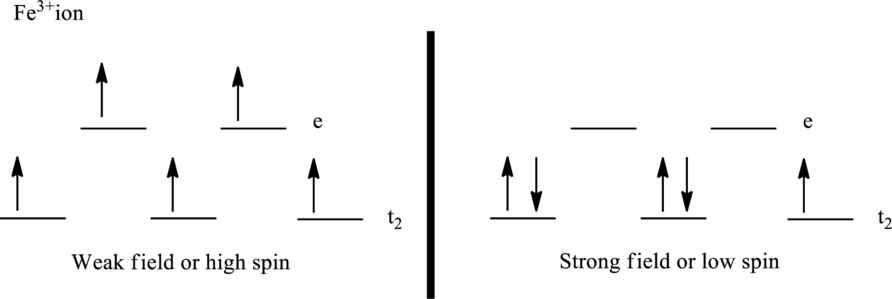
Concept explainers
(a)
Interpretation:
Formula for the octahedral complex ion has to be written that has
(a)
Explanation of Solution
Octahedral complex contains six ligands inside the coordination sphere. Central metal atom is given as
(b)
Interpretation:
Complex that is formed from
(b)
Explanation of Solution
Octahedral complex ion that is formed from
Octahedral complex ion that is formed from
(c)
Interpretation:
Complex that has more paramagnetism has to be chosen.
(c)
Explanation of Solution
Octahedral complex ion that is formed from
Octahedral complex ion that is formed from
The crystal field model for high-spin and low-spin complex of

Number of unpaired electrons:
The ligand
Paramagnetism depends upon the number of unpaired electrons. Therefore, the complex ion
(c)
Interpretation:
Crystal field diagram for the
(c)
Explanation of Solution
Octahedral complex ion that is formed from
Octahedral complex ion that is formed from
The central metal ion is

Want to see more full solutions like this?
Chapter 20 Solutions
Chemistry: The Molecular Science
- Experiments show that K4[Cr(CN)6] is paramagnetic and has two unpaired electrons. The related complex K4[Cr(SCN)6] is paramagnetic and has four unpaired electrons. Account for the magnetism of each compound using the ligand field model. Predict where the SCN ion occurs in the spectro-chemical series relative to CN.arrow_forwardGive the number of unpaired electrons in octahedral complexes with strong-field ligands for (a) Rh3+ (b) Mn3+ (c) Ag+ (d) Pt4+ (e) Au3+arrow_forward
 Chemistry: The Molecular ScienceChemistryISBN:9781285199047Author:John W. Moore, Conrad L. StanitskiPublisher:Cengage Learning
Chemistry: The Molecular ScienceChemistryISBN:9781285199047Author:John W. Moore, Conrad L. StanitskiPublisher:Cengage Learning Chemistry: Principles and PracticeChemistryISBN:9780534420123Author:Daniel L. Reger, Scott R. Goode, David W. Ball, Edward MercerPublisher:Cengage Learning
Chemistry: Principles and PracticeChemistryISBN:9780534420123Author:Daniel L. Reger, Scott R. Goode, David W. Ball, Edward MercerPublisher:Cengage Learning Chemistry: An Atoms First ApproachChemistryISBN:9781305079243Author:Steven S. Zumdahl, Susan A. ZumdahlPublisher:Cengage Learning
Chemistry: An Atoms First ApproachChemistryISBN:9781305079243Author:Steven S. Zumdahl, Susan A. ZumdahlPublisher:Cengage Learning
 ChemistryChemistryISBN:9781305957404Author:Steven S. Zumdahl, Susan A. Zumdahl, Donald J. DeCostePublisher:Cengage Learning
ChemistryChemistryISBN:9781305957404Author:Steven S. Zumdahl, Susan A. Zumdahl, Donald J. DeCostePublisher:Cengage Learning Chemistry & Chemical ReactivityChemistryISBN:9781133949640Author:John C. Kotz, Paul M. Treichel, John Townsend, David TreichelPublisher:Cengage Learning
Chemistry & Chemical ReactivityChemistryISBN:9781133949640Author:John C. Kotz, Paul M. Treichel, John Townsend, David TreichelPublisher:Cengage Learning





